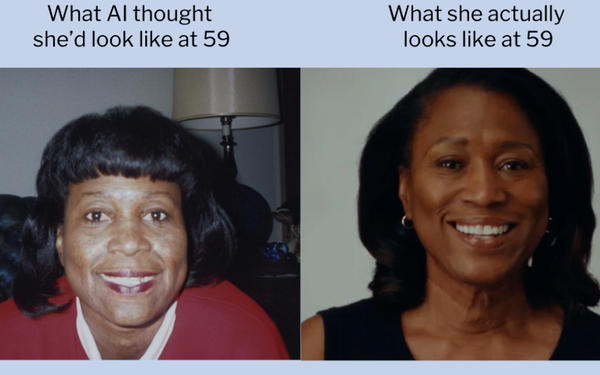artificial intelligence
Olay Cozies Up To Loyalists In AI Challenge
- by Sarah Mahoney @mahoney_sarah, April 16, 2024

Anyone on social media knows how unavoidable those “how will you look as you age” filters are. In a new campaign, Olay offers a twist, asking some of the brand’s biggest fans to use an old photo and then compare the AI predictions to their actual appearance.
Using Procter & Gamble’s proprietary skin technology, these people get a close-up look at how AI thinks they should look as they’ve aged, and how their skin actually appears. Thanks to the steady use of Olay products, they’ve got fewer fine lines, wrinkles, sagging and age spots than AI predicted.
“We’ve always had this core group of older customers who have used Olay products for years,” says John Grim, senior brand director, Olay North America. "These are the kind of people who are used to having people compliment them and ask them what products they use to have such healthy skin.”
advertisement
advertisement
The point, of course, is that with Olay in their medicine cabinet, their skin will age better.
The campaign's first stage focuses on four women; more are in the works. “We put out something of a casting call for happy long-term users and have been overwhelmed by how many have responded,” Grim tells Marketing Daily.
The campaign, created by Vayner Media, supports Olay Regenerist Micro-sculpting Cream and its Retinol 24 + Peptide Night Moisturizer.
Grim says that while the ads star older women, “they work well with younger people, too, who see the ads as proof of how well Olay works.”
Olay is no stranger to using AI in skin analysis. It introduced its first AI-driven Olay Skin Advisor in 2017, working closely with Canfield Scientific, which also helped develop the tool used in this campaign. (P&G also worked with Canfield to develop the Vizia Machine, which has been analyzing skin in dermatologists’ offices since the 1990s.)
But these days, it is also possible that consumers will interpret the ad campaign another way, chalking it up to yet another example of AI’s unwelcome and distorting impact on women’s sense of themselves.
Last week, Unilever’s Dove, a major Olay competitor, pledged never to use AI-generated women in its communications. In a spot called “The Code,” it says that by next year, 90% of online content will be generated by AI. It asks: “What kind of beauty do we want AI to learn?” And as part of its 20-year-old “Real Beauty” effort, it vows never to use an AI-generated image.
P&G vowed to stop photo retouching in its ads several years ago.
Grim says users seem to be responding positively to the campaign. But consumer sentiment about AI images -- even when specifically called out as AI in efforts like this -- is very much a moving target. A recent study from Publicis and Yahoo finds that while 77% of advertisers see AI positively, only 38% of consumers share that view.
“Consumers are less concerned about brands and marketers using AI, but rather identifying when AI is used,” says Elizabeth Herbst-Brady, Yahoo’s chief revenue officer, in the study. “Transparency will be vital for brands to maintain long-term consumer relationships and generate positive brand equity.”




